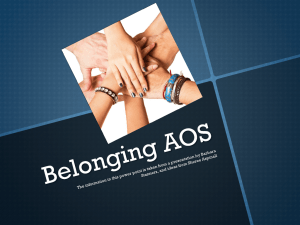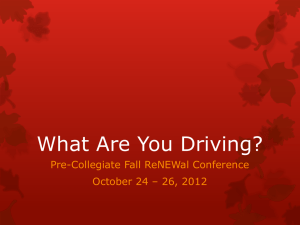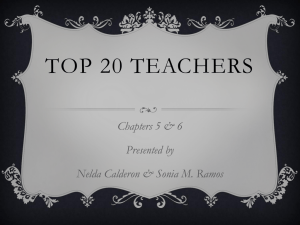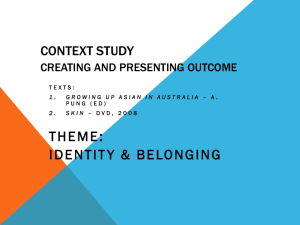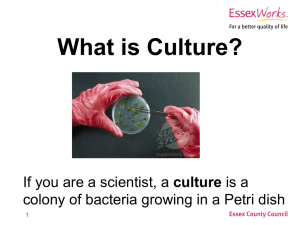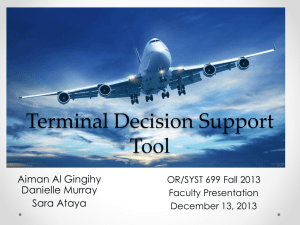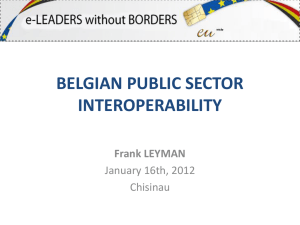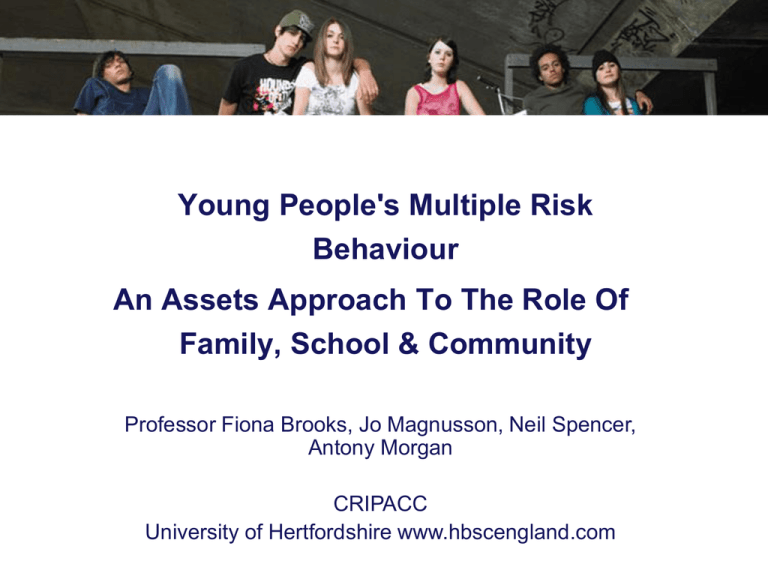
Young People's Multiple Risk
Behaviour
An Assets Approach To The Role Of
Family, School & Community
Professor Fiona Brooks, Jo Magnusson, Neil Spencer,
Antony Morgan
CRIPACC
University of Hertfordshire www.hbscengland.com
What is HBSC?
Unique international study that gathers data from young
people about their health and wellbeing
Purpose to increase knowledge and understanding of adolescent
health in relation to their social and developmental context
HBSC surveys conducted every 4 years in member countries
Standard international questionnaire & survey method
plus optional question packages
Data collected on 11,13 and 15 year olds in 43 member
countries across Europe and North America.
Measures in HBSC
Measures
Health Related
Behaviours
Includes measures on
physical, emotional and
social health and wellbeing
Measures
comprehensive range
of behaviours both risk
and promote health
Places health and
behaviour of young
people in social and
developmental context
Health and
Well-being
Family Life
School
Peers and
Community
Premise
•Adolescence perceived as period of ‘risk taking’ –
BUT Risk behaviours often looked at in isolation
•Certain amount of risk taking among young people is
‘normal’
•Frequent involvement in multiple risk behaviours may
be problematic
•Need to understand what assets operate to protect
against young people getting involved in multiple risk
behaviours
40 Development Assets (Scales, 2001)
Support (family
relationships, caring
school and
neighbourhood)
Empowerment (community
values youth, young
people seen as
resources)
Constructive use of time
(participation in clubs and
associations)
Commitment to learning
(achievement motivation)
Positive values (caring and
responsible to others)
Social competencies
(cultural competence,
peaceful conflict
resolution
Positive identity (self
esteem
BUT…. REPRESENT A
STARTING POINT….
Modelling Assets Using HBSC
• Are some assets (protective factors) more
important than others? - keystone
• What are the cumulative effects of multiple assets
on young people's mental and physical well being?
• What are the processes that lead to assets having
an impact ?
• How do different social and cultural contexts impact
on the benefits of these assets?
– UK context
• Are some assets more important for different
groups?
Multiple substance use among 15 year olds
Assets Modelling
Assets
Four categories of assets were investigated:
1. sense of belonging (associated with family
(FSB), school (SSB) and neighbourhood
(NSB))
2. autonomy (personal autonomy in relation to
family (PAF), and peers (PAP), and student
autonomy in relation to school (SAS)
3. social networking (associated with
neighbourhood (NSN))
4. social support (associated with family
communication with father (FCF), family
communication with mother (FCM), teachers
(TSS) and peers (PSS))
Questions used to assess risk
Score 0
Score 1
Score 2
No
Yes,
More than
were really drunk?
once
once
On how many occasions (if any) have you drunk None
One or
More than
alcohol in the last 30 days?
two
two
One or
More than
smoked cigarettes in the last 30 days?
two
two
On how many occasions (if any) have you taken None
One or
More than
cannabis (sometimes called pot, dope or weed)
two
two
Yes
No
Have you ever had so much alcohol that you
On how many occasions (if any) have you
None
in the last 12 months?
The last time you had sexual intercourse, did
Have never
you or your partner use a condom?
had sexual
intercourse
Risk Behaviour Index
• 1087 students provided information on all the
risk behaviour variables
• 32% no risk category
• 50% moderate or some risk (1-5)
• 18 % high risk (score 6-10)
Effects retained in the model
• Personal autonomy in relation to family
– Lower personal autonomy associated with lower risk
• School sense of belonging.
– High school sense of belonging associated with lower risk
• Neighbourhood sense of belonging
– Medium or high neighbourhood sense of belonging
associated with lower risk
Interaction effects
• School Social Support (via teachers) (TSS), and
Gender
– Girls had lower risk than boys when TSS was high
• School Social Support (via teachers) (TSS), and Family
Sense of belonging (FSB),
– High levels of TSS was associated with less risk than medium
TSS, but low levels of TSS was associated with greater risk
only when FSB was also low.
Family Findings Illustrate
• How parental regulation of adolescent autonomy and
negotiation over leisure operates as a protective
mechanism against multiple and high frequency risk
behaviours.
• family affluence not retained in the model adds weight
to the need to understand health related risk taking in
adolescence as determined by a broad range of
contextual factors.
School
• Findings indicate the importance of adults
other than parents, as protective assets
for the health and wellbeing of young
people, especially in relation to the
significance of having a personal
connection to a teacher when parental
connectivity may be low.
Community
• considered how informal aspects of the local
environment have significance for young
people.
• Illustrates significance of growing up in a
community with strong cohesion in which
adolescents feel a positive sense of belonging.
• Young people’s feelings of safety in the out of
home setting, having a place in their
community and perceiving the wider adult
community as supportive, - important
protective function
Multiple substance use among 15 year olds
Protective Factors/Assets – most
vulnerable
1. Parental participation in how spend free
time
2. Teacher Connectedness
3. Feeling safe in community and having
friendly neighbourhood
Main Findings
• Core domains of social capital operate as protective assets
– in terms of frequency and clustering of high risk behaviours.
• Levels of autonomy within the family and teacher support were
important predictors of adolescent health related behaviours.
• A positive sense of community cohesion and belonging is a
significant protective asset
• Low teacher connectedness becomes a significant risk factor
when family control over autonomy was also low.
• No relationship was found between involvement in multiple
substance use over the last 30 days and family affluence
(FAS).
Key issues
Highlights key aspects of physical health and family, school and
community life that may be most significant in terms of
contributing to protecting against multiple risk behaviours
• Feeling safe and comfortable in community environments
• Parental Monitoring
•more important than family activities and communication for this
aspect of adolescent well-being NOT others
•Protective aspects of teacher connectedness
Peers less important as a protective asset than might be
anticipated
Thank-you
Paper: Brooks, F., Magnusson, J., Spencer, N. & Morgan, A.
(2012) Adolescent Multiple Risk Behaviour: An Assets Approach
To The Role Of Family, School And Community Journal Of
Public Health, 34 48-56.
Effects retained in the model
Patterns across the risk index for PAF, SSB and NSB
No risk
Some risk
High risk
Score 0
Score 1-5
Score 6-10
Low
44%
37%
19%
Medium
28%
56%
16%
High
18%
58%
24%
Low
17%
58%
25%
Medium
21%
54%
25%
High
29%
56%
15%
Low
14%
43%
43%
Medium
25%
54%
21%
High
26%
58%
17%
Personal autonomy in relation to family
(PAF)
School sense of belonging (SSB)
Neighbourhood sense of belonging (NSB)
Assets Patterns Across the Risk Index
Patterns across risk index for interaction between FSB and TSS
No risk
Some risk
High risk
Score 0
Score 1-5
Score 6-10
FSB
TSS
Low
Low
7%
9%
84%
Medium
18%
53%
29%
High
25%
56%
20%
Low
17%
51%
32%
Medium
20%
55%
26%
High
25%
60%
15%
Low
26%
74%
0%
Medium
23%
59%
17%
High
37%
53%
10%
Medium
High


